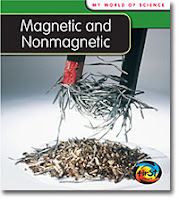There are a lot of books available for children about the solar system in both the picture book and nonfiction sections of the library. Fourth graders are at an age where they still need and appreciate small and sometimes fictional books about scientific concepts. The picture books are good because they explain the information simply and encourage children to use their imaginations about science concepts. The nonfiction books contain more accurate illustrations and actual pictures of the planets and ideas that are described.
Books
 Destination: Space By Seymour Simon. (2006). 32p. Collins. 9780060877231. Gr. 3.
Destination: Space By Seymour Simon. (2006). 32p. Collins. 9780060877231. Gr. 3.This book has big photographs of different features of the solar system, such as nebulas, supernovas, and planets. Beside each photograph is a detailed description of the photograph. Although the reading level would be about grade 3, each page contains a lot of interesting facts that older children would like, as well.
 Exploring the Solar System: A History with 22 Activities. By Mary Kay Carson. (2008). 176p. Chicago Review Press, 9781556527159. Gr.4-5.
Exploring the Solar System: A History with 22 Activities. By Mary Kay Carson. (2008). 176p. Chicago Review Press, 9781556527159. Gr.4-5.This book is full of facts, history, and activities relating to the solar system. There is extensive information about each planet. Information about famous astronomers is provided as well. Predictions for future discoveries and explorations are also made.
By Monica Grady. Illus. by Lucia deLeiris. (2007). 32p. Francis Lincoln Children's Books, 9781845075705. Gr. 3-4.
This book gives simple yet detailed information about many different parts of the solar system. The illustrations are good. The descriptions include explanations of where each planet, moon, or star comes from. There is a glossary in the back.
By David Aguilar. (2011). 64p. National Geographic Children's Books, 9781426307706. 4-5 Gr.
This book provides up-to-date information about the thirteen planets. There are enhanced photographs on every page. There are activities in the back. This book contains simple text, but would be applicable for fourth-fifth grade just as well.
 The Magic School Bus: Lost in the Solar System By Joanna Cole. Illus. by Bruce Degen. (1992). 40p. Scholastic Press, 9780590414296. Gr. 3-4.
The Magic School Bus: Lost in the Solar System By Joanna Cole. Illus. by Bruce Degen. (1992). 40p. Scholastic Press, 9780590414296. Gr. 3-4.This book is an entertaining way to get kids interested in studying the solar system. There is humor, conversation bubbles, facts, and an interesting story. There are also many different illustrations on each page. Fourth graders may still find this book useful.
Websites
For Teachers
This website provides detailed information about different topics relating to the solar system. Meteors, the Moon, stars, comets, planets, and the Sun are discussed. The size, temperature, and other characteristics are mentioned.
This website provides information on topics relating to the solar system as well as news articles and information about past and future space exploration. There are resources available for teachers and kids.
This website gives lesson plan ideas and game ideas for teaching the about the solar system. It also gives recommendations for websites and books that teachers and kids can use.
For Kids
Kids' Astronomy
This website has icons for the planets and their moons. There is an interactive replica of the planets and how they rotate on their axes. There are games, also.
Kids' Astronomy
This website has icons for the planets and their moons. There is an interactive replica of the planets and how they rotate on their axes. There are games, also.
This website would be useful for teachers and kids who are interested in exploring history of space exploration further. There are detailed descriptions and pictures of many past U.S. vessels which were launched into space. There are current news articles about space exploration.
For Teachers
Virginia Standard of Learning
SOL 4.7 The student will investigate and understand the organization of the solar system. Key concepts include:
(a) planets in the solar system.
Background Information from Curriculum Framework
Background Information from Curriculum Framework
Look under 4.7: I could not paste the material.






























